人教版英语必修二unit1公开课教案
- 格式:docx
- 大小:397.73 KB
- 文档页数:3
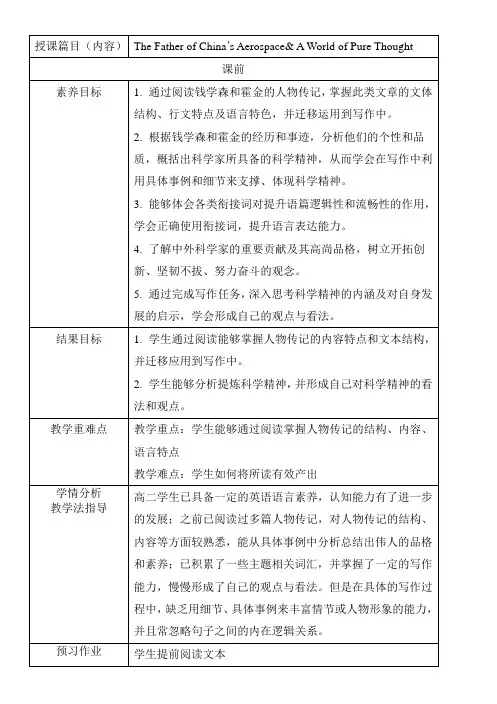
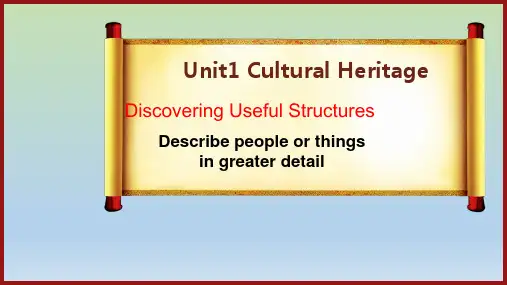

人教版必修二Unit 1 Reading and ThinkingFrom Problems to Solutions教学设计I. Textbook AnalysisThe lesson focuses on the reading and thinking passage titled "From Problems to Solutions," which is an expository text discussing how to address challenges through innovative solutions. The text takes the construction of the Aswan Dam in Egypt as an example, illustrating the process of identifying problems, seeking solutions, and achieving success.II. Learning ObjectivesLanguage Skills:Students will be able to read and understand the passage independently.They will be able to summarize the main ideas and details of the text.Grammatical Knowledge:Students will review and practice using past participles as attributives and object complements.They will learn and apply new vocabulary related to the topic, such as "proposal," "protest," "investigate," etc.Thinking Skills:Students will develop critical thinking skills by analyzing the problem-solving process in the text.They will learn to apply the problem-solving model to real-life situations.Cultural Awareness:Students will gain insights into the cultural and historical context of the Aswan Dam project.They will appreciate the importance of international cooperation in addressing global challenges.III. Teaching ProceduresStep 1: Lead-in (5 minutes)Ask students what they know about Egypt and its famous landmarks. Introduce the Aswan Dam and its significance, setting the stage for the reading passage.Step 2: Pre-reading Activities (10 minutes)Activity 1:Provide students with a list of new vocabulary related to the text and have them predict their meanings based on context clues.Activity 2:Have students read the title and the first paragraph of the text, and ask them to predict what the rest of the text will be about.Step 3: While-reading Activities (20 minutes)Activity 1: Have students read the text silently and underline key information related to the problem (construction of the Aswan Dam and potential damage to cultural relics) and the solution (establishment of a committee, international cooperation, and successful relocation of temples).Activity 2: After reading, ask students to answer comprehension questions such as:1.Why did the Egyptian government want to build the dam?2.What was the main concern of the protesters?3.How was the problem eventually solved?Activity 3: Have students work in pairs to create a mind map summarizing the problem-solving process in the text.Step 4: Post-reading Activities (15 minutes)Activity 1:Discuss the importance of finding a balance between economic development and cultural preservation. Ask students to give examples of similar challenges faced by other countries.Activity 2:Have students read paragraphs 1, 2, and 6 again and discuss the main idea of the text. Guide them to understand that big challenges can sometimes lead to great solutions.Activity 3:Write a short paragraph (60-80 words) summarizing the text based on the mind map they created. Encourage students to use the new vocabulary and grammatical structures learned in the lesson.Step 5: Language Focus (10 minutes)Review and practice using past participles as attributives and object complements with examples from the text. Have students create their own sentences using this structure.Step 6: AssignmentHave students research another example of a problem-solving project and write a short report on it, emphasizing the problem, the solution, and the importance of cooperation.IV. AssessmentFormative Assessment:Observe students during class discussions and activities to assess their understanding and engagement.Summative Assessment:Evaluate students' written summaries and homework assignments for accuracy, coherence, and use of new vocabulary and grammatical structures.。
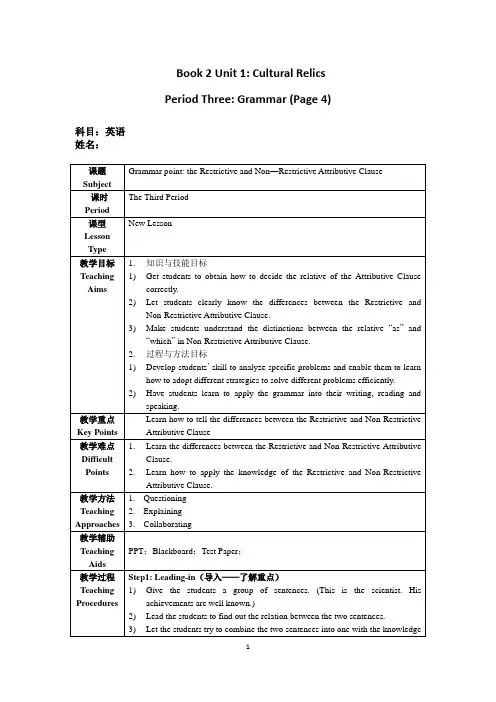

Unit1口语课教案Talk About History and Culture一、Teaching Objectives:By the end of this lesson, students will be able to:1. Describe the importance of understanding history and culture in today's world.2. Explain the relationship between history and culture.3. Discuss at least three historical events or cultural practices that have shaped their own lives or communities.4. Use appropriate language and expressions to discuss historical and cultural topics.5. Participate in group discussions and express their opinions confidently.二、Teaching Key Points:1. The significance of understanding history and culture in today's globalized world.2. The connection between history and culture, including how they influence each other.3. Historical events and cultural practices as sources of personal and community identity.4. Use of academic vocabulary related to history and culture.5. Group discussion skills and active listening.三、Materials:1. PowerPoint presentation with images, videos, and relevant information about historical events and cultural practices.2. Handouts with key terms and phrases related to history and culture.3. Whiteboard and markers for note-taking and group activities.4. Access to online resources for further research on specific historical events or cultural practices.四、Teaching Procedures:1. Warm-up (5 minutes)●Begin the class by asking students what they know about history and culture.Encourage them to share their thoughts and opinions.●Write their responses on the board or display the handout for everyone to see.This will help set the stage for the rest of the lesson.2. Presentation (15 minutes)●Introduce the topic by explaining why it is important to understand history andculture in today's globalized world. Use examples from current events toillustrate your points.●Present the key points using a PowerPoint presentation, images, videos, andrelevant information about historical events and cultural practices.●Encourage students to take notes on the content, key terms, and phrases related tohistory and culture.3. Practice (15 minutes)●Divide students into small groups of four or five people. Assign each group oneof the historical events or cultural practices discussed in the lesson (e.g., the Great Wall of China, Thanksgiving Day, traditional clothing styles).●Ask each group to research their assigned topic using online resources or booksfrom the school library. They should prepare a short presentation (5-7 minutes) to share with the class.●During the presentation, students should use appropriate language andexpressions related to history and culture, such as "symbolic of," "reflective of,""played a significant role in shaping," etc. They should also engage in group discussions, answering questions from other groups and offering additional insights based on their research.●After each group presents, ask for a show of hands to see who would like to addcomments or questions about their topic. This will encourage active listening and promote critical thinking skills among students.4. Production (15 minutes)●Regroup students into larger groups of ten or twelve people, depending on classsize. Assign each group one of the following tasks: writing a persuasive essay on the importance of understanding history and culture, creating a skit or play that highlights a historical event or cultural practice, designing a poster or brochure that promotes cross-cultural understanding, or preparing a podcast episode that explores different aspects of history and culture.●Give students time to work on their tasks, encouraging them to use the notes theytook during their research earlier in the lesson as a starting point for their projects.Encourage them to incorporate academic vocabulary related to history and culture into their work.●At the end of the production time, ask each group to share their work with theclass, explaining their ideas and choices behind their projects. Allow time for questions and feedback from the class before moving on to the next activity.5. Conclusion (5 minutes)●Review the key points covered in the lesson, including the importance ofunderstanding history and culture, their relationship, and how historical events and cultural practices shape personal and community identity.●Ask students to reflect on what they learned during the lesson and how it mightapply to their own lives or communities. Encourage them to continue exploring history and culture through reading, watching documentaries, attending cultural events, or engaging in discussions with peers who come from different backgrounds.●Assign homework assignments if necessary (e.g., writing a reflection paper on ahistorical event or cultural practice that has had an impact on you, participating ina local cultural festival, etc.). Provide clear instructions on how to submit theassignments electronically or by hand.五、Assessment:Students will be assessed through various forms of assessment throughout the lesson, including:1. Group presentations: Students will be evaluated on their ability to research, present, and participate in group discussions related to their assigned historical events or cultural practices. They will also be expected to use academic vocabulary and demonstrate critical thinking skills during these activities.2. Independent work: Students will be assessed on their ability to apply academic vocabulary related to history and culture to their written projects (e.g., persuasive essays, skits or plays). They should demonstrate an understanding of how historical events and cultural practices have shaped personal and community identity through their writing.。
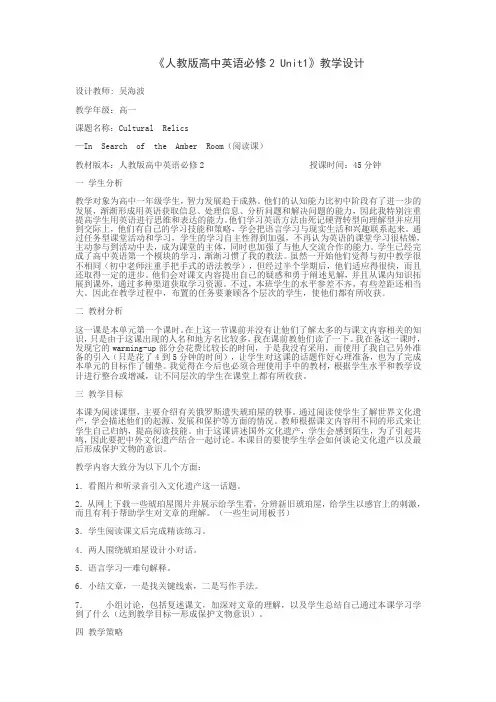
《人教版高中英语必修2 Unit1》教学设计设计教师: 吴海波教学年级:高一课题名称:Cultural Relics—In Search of the Amber Room(阅读课)教材版本:人教版高中英语必修2 授课时间:45分钟一学生分析教学对象为高中一年级学生,智力发展趋于成熟。
他们的认知能力比初中阶段有了进一步的发展,渐渐形成用英语获取信息、处理信息、分析问题和解决问题的能力,因此我特别注重提高学生用英语进行思维和表达的能力。
他们学习英语方法由死记硬背转型向理解型并应用到交际上,他们有自己的学习技能和策略,学会把语言学习与现实生活和兴趣联系起来。
通过任务型课堂活动和学习,学生的学习自主性得到加强,不再认为英语的课堂学习很枯燥,主动参与到活动中去,成为课堂的主体,同时也加强了与他人交流合作的能力。
学生已经完成了高中英语第一个模块的学习,渐渐习惯了我的教法。
虽然一开始他们觉得与初中教学很不相同(初中老师注重手把手式的语法教学),但经过半个学期后,他们适应得很快,而且还取得一定的进步。
他们会对课文内容提出自己的疑惑和勇于阐述见解,并且从课内知识拓展到课外,通过多种渠道获取学习资源。
不过,本班学生的水平参差不齐,有些差距还相当大。
因此在教学过程中,布置的任务要兼顾各个层次的学生,使他们都有所收获。
二教材分析这一课是本单元第一个课时。
在上这一节课前并没有让他们了解太多的与课文内容相关的知识,只是由于这课出现的人名和地方名比较多,我在课前教他们读了一下。
我在备这一课时,发现它的warming-up部分会花费比较长的时间,于是我没有采用,而使用了我自己另外准备的引入(只是花了4到5分钟的时间),让学生对这课的话题作好心理准备,也为了完成本单元的目标作了铺垫。
我觉得在今后也必须合理使用手中的教材,根据学生水平和教学设计进行整合或增减,让不同层次的学生在课堂上都有所收获。
三教学目标本课为阅读课型,主要介绍有关俄罗斯遗失琥珀屋的轶事。
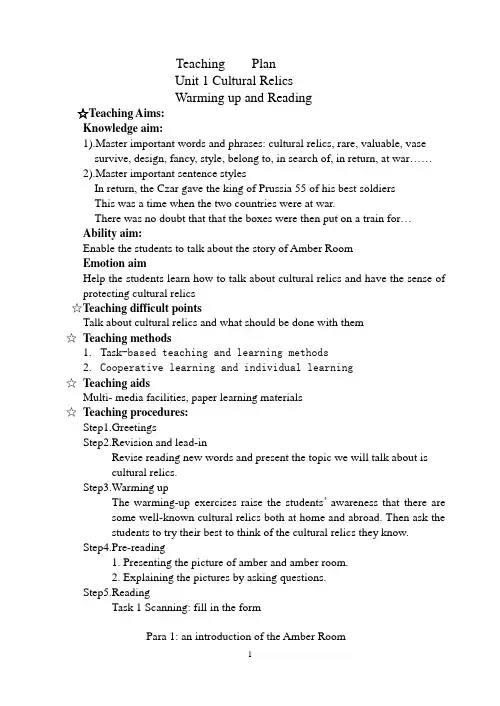
Teaching PlanUnit 1 Cultural RelicsWarming up and Reading☆Teaching Aims:Knowledge aim:1).Master important words and phrases: cultural relics, rare, valuable, vasesurvive, design, fancy, style, belong to, in search of, in return, at war……2).Master important sentence stylesIn return, the Czar gave the king of Prussia 55 of his best soldiersThis was a time when the two countries were at war.There was no doubt that that the boxes were then put on a train for…Ability aim:Enable the students to talk about the story of Amber RoomEmotion aimHelp the students learn how to talk about cultural relics and have the sense of protecting cultural relics☆Teaching difficult pointsTalk about cultural relics and what should be done with them☆Teaching methods1.Task-based teaching and learning methods2.Cooperative learning and individual learning☆Teaching aidsMulti- media facilities, paper learning materials☆Teaching procedures:Step1.GreetingsStep2.Revision and lead-inRevise reading new words and present the topic we will talk about iscultural relics.Step3.Warming upThe warming-up exercises raise the students’awareness that there aresome well-known cultural relics both at home and abroad. Then ask thestudents to try their best to think of the cultural relics they know.Step4.Pre-reading1. Presenting the picture of amber and amber room.2. Explaining the pictures by asking questions.Step5.ReadingTask 1 Scanning: fill in the formPara 1: an introduction of the Amber RoomTask 2 Skimming: Answer the following questionsPara 2: A gift to Peter the GreatQ1: What was the Amber Room first made for?Q2: What happened to the Amber Room in 1716?Task 3 Skimming: Choose the best answerPara 3: The changes of the Amber RoomWho had the Amber Room moved to a place outside St Petersburg?A. Frederick WilliamⅠB. Catherine ⅡC. Peter the GreatD. FrederickⅠTask 4 Careful reading: Complete the short passage according to Para 4 Para 4: The missing of the Amber RoomIn _______, the Russians and the Nazis were _____ ______. Before the Nazis could get to the summer palace, the _______ were able to remove some_______ and small ______ ______ from the Amber Room. However, some of the Nazis secretly ______ ______ ______ itself. After that, what happened to the Amber Room remains a _________.Task 5 Para 5 A new Amber RoomAnswer the following questions:Q1: Who have built a new Amber Room?Q2: How old is St Petersburg now?Step 6 SummaryStep7. Homework1. Review what we have learnt today2. Read the passage fluently and finish the exercises3. Prepare for the next lessonUnit 1 Cultural RelicsWarming up and Reading学案Step 1 Warming upDiscuss the following questions:1.What is a cultural relic?A cultural relic _______(be) something that can represent ________(文化),which_____ ________(已经幸存下来) for a long time to tell the ______(历史) and it is very ________(罕见的)and ________(有价值的). ______ ________ (文化遗产) can be craftworks, buildings, books, paintings music and so on.2. Does a cultural relic always have to be rare and valuable?3. Is it enough to have survived for a long time?Step 2 Pre- readingHave you ever seen a piece of amber?Do you know what the Amber Room is made of?Can you imagine a house made of amber?Judging from the title, what do you think happened to the Amber Room?Step 3 ReadingTask 1 Scanning: fill in the formTask 2 Skimming: Answer the following questionsPara 2: A gift to Peter the GreatQ1: What was the Amber Room first made for?Q2: What happened to the Amber Room in 1716?Task 3 Skimming: Choose the best answerPara 3: The changes of the Amber RoomWho had the Amber Room moved to a place outside St Petersburg?________A. Frederick WilliamⅠB. Catherine ⅡC. Peter the GreatD. FrederickⅠTask 4 Careful reading: Complete the short passage according to Para 4 Para 4: The missing of the Amber RoomIn _______, the Russians and the Nazis were _____ ______. Before the Nazis could get to the summer palace, the _______ were able to remove some_______ and small ______ ______ from the Amber Room. However, some of the Nazis secretly ______ ______ ______ itself. After that, what happened to the Amber Room remains a _________.Task 5 Para 5 A new Amber RoomAnswer the following questions:Q1: Who have built a new Amber Room?Q2: How old is St Petersburg now?Step 4 Summary1.Match each part of the passage with its headlinePara 1 a. the transform of the Amber Room as a gift and itschangePara 2-3 b. A new Amber RoomPara 4 c. Brief introduction to the Amber RoomPara 5 d. The missing of the Amber Room2. What is the main idea of the passage?It tells us the strange history of the _______ ________, a cultural relic of two countries: ________ and__________.Step 5. Homework1. Review what we have learnt today2. Read the passage fluently and finish the exercises3. Prepare for the next lesson。
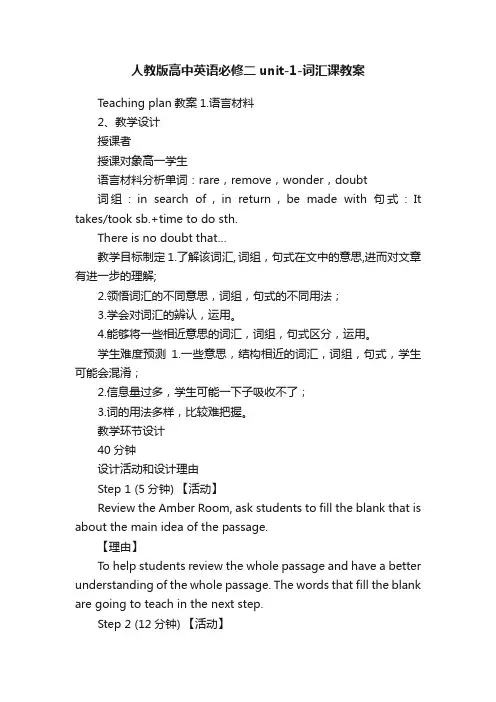
人教版高中英语必修二unit-1-词汇课教案Teaching plan教案1.语言材料2、教学设计授课者授课对象高一学生语言材料分析单词:rare,remove,wonder,doubt词组:in search of,in return,be made with 句式:It takes/took sb.+time to do sth.There is no doubt that…教学目标制定1.了解该词汇, 词组,句式在文中的意思,进而对文章有进一步的理解;2.领悟词汇的不同意思,词组,句式的不同用法;3.学会对词汇的辨认,运用。
4.能够将一些相近意思的词汇,词组,句式区分,运用。
学生难度预测1.一些意思,结构相近的词汇,词组,句式,学生可能会混淆;2.信息量过多,学生可能一下子吸收不了;3.词的用法多样,比较难把握。
教学环节设计40分钟设计活动和设计理由Step 1 (5分钟) 【活动】Review the Amber Room, ask students to fill the blank that is about the main idea of the passage.【理由】To help students review the whole passage and have a better understanding of the whole passage. The words that fill the blank are going to teach in the next step.Step 2 (12分钟) 【活动】1.Show some relative pictures to introduce the word ;2.Explain some important usage of the word;3.Show other pictures and ask students to describe the pictures with the wordjust learn, or give some multiple choice exercise, or translation, or askstudents to do some matching..【理由】/doc/fa17844806.html,ing pictures can let students feel interesting and help them understand the word;2.Help students understand the word well and tell the important usage ;人教版高中英语必修2 Unit 1 Page1~2 词汇课3.Different exercise can help students to use the words correctly.Step 3 (12分钟) 【活动】1.Show the original sentences of the passage that involve the phrase;2.Show other sentences that involve the same phrase and help students to find out theusage and meaning of the phrase;/doc/fa17844806.html,pare the phrase with other phrases that have the similar meaning or usage and help students to distinguish them;4.Some exercise that help students to use the phrases.【理由】1.Teach students how to guess the meaning of new phrases;2.Help them remember these phrases and their usage;3.Help students to distinguish some similar phrases;4.Help them be able to use these phrases and use them correctly.Step 4 (6分钟) 【活动】1.Show the original sentences of the text and show other sentences that have the samepattern as the original sentences;2.Guide students find out the sentences’ pattern;3.Explain the usage of the sentences’ pattern;4.Ask students to make up some sentences with the sentences pattern and do sometranslation.【理由】1.Help students find out the sentences’pattern by themselves;2.Teach students how to use those sentences’ pattern correctly.Step 5 (5min) 【活动】1. Review the words and phrase;2. Emphasize some important words or phrases that students may still not understand well and ask students to review them after class;2. Assign the work after class;【理由】1.Help students to remember the new knowledge;2.Help students to review the new knowledge;3.Remind students to review the new knowledge.上一页下一页。

必修二unit1教案【篇一:新人教版必修二unit1 cultural relics教学设计】unit 1 cultural relicsteaching goals教学目标1). ability goals能力目标a.learn some detailed information about the amber room.b.improve the students’ reading ability.c.train the students’ ability to grasp key information while listening.d.enable the students to have the ability of talking culturalrelics and ways to protect them.2). learning ability goals学能目标help the ss to learn how to give opinions clearly about cultural relics.3)emotion:情感目标train the students’ ability to cooperate with others.enable the ss to talk about the story of the amber roomteaching important points教学重点1 ).the new words and expressions;2). learn some detailed information about the amber room;3). train the students’ ability to cooperate with others;4). train the students’ speaking ability.learn to discuss and act out the ss’ opinions about cultural relics.teaching important points教学难点1)words:ton, stone, heat, design, fancy, style, jewel, king, reception, light, mirror, wonder;2)phrases:look into, belong to, in search of, in return, at war, take apart, think highly of;3). sentence patterns:(1) there is no doubt that…..(2) this gift was the amber room, which was given this name because almost seven thousand tons of amber were used to make it.4). improve the students’ reading ability.train the students’ ability to grasp key information while listening.how to teach the students to speak out their opinions about cultural relics. teaching methods教学方法1). watch some videos about the cultural relics. (individuals)2). have a discussion. (group work)3). write an article about the discussion. (individuals)teaching aids教学设备a computer, a projector and some slides.teaching procedures and ways教学过程与方式the first second period (vocabulary,warming up andpre-reading)teaching goals:1. target languagecultural, survive, remain, state, rare, dynasty, vase, belong to 2. learning ability goalshelp the students learn how to talk about cultural relics and have the sense of protecting cultural relics.teaching important pointstalk about cultural relics and what should be done with them.teaching difficult points:how to talk about cultural relics.teaching methods:group discussion and presentation.(cooperative learning)the first second periodteaching procedures:step 1 new words teachingstep 2 warming-upt: when talking about cultural relics, what comes to your mind? s1: the great wall.s2: the pyramids in egypt.s3: …t: well done.teacher asks the ss to look at the three groups of pictures and discuss these questions.1. do you know these places?2. if you know, what do you know about the places?3. which one would you like to visit? why?i: as is known to all, china is a country with a history of more than 5,000 years. in the long history, people in differentperiods have left us quite a number of cultural sites, many of which are world famous. now look at the pictures and guess what heritage they are.all these are cultural relics.do you know any other cultural relics in the world?t shows the ss some cultural relics abroad.task 1: ask the ss to make a dialogue by saying.imagine you have a chance to travel these places. which place would you like to go? why? when are you starting off? how are you getting there? how long are you staying?please make a dialogue with your partners. then students answer the following questions:what is your favorite city? why?what makes a city great and famous?(a long history; cultural relics; many great people; important events taking placethere)t:unfortunately, some of them are in danger because they are destroyed, and some of them were lost because someone stole them.task 2: now suppose that you work for the state office of cultural relics. you are sent to a small town where you find a relic that was stolen from a palace. it is a rare ming dynasty vase. the man who has it insists that it belongs to his family. what will you say to him?work in pairs to discuss this question, and then i’ll ask some ss to tell me your answers.step 3 task 3 speaking task on page 46debate do you think china should save all of its cultural relics? do you think it necessary to rebuild yuanmingyuan in beijing? t: after watching so many pictures, now discuss with your partners the following question:what is a cultural relics?(ss can find the answer from the warming up.)step 4 pre-readingt: ok, class, do you think these cultural relics are beautiful?ss: yes, very beautiful.t: suppose one of them got lost, how would you feel and what will you do with it? s1: try our best to find it.s2: protect the others in order that they will not lost. ……t: thanks for your good suggestions. if you find a cultural relic, what will you do with it? you can make a dialogue with your partner on this question.t can practice it with a student to give an example.extending questions: to whom do cultural relics belong?step 5 language points1) survivesurvive: vi. continue to live or exist.in alive after sb., live or exist longer thane.g: many strange customs have survived from earlier times.her parents died in the accident, but she survived.few buildings survived the earthquake.the man survived his sister by three years.2) (a) part ofa part of the books have arrived.a leg is a part of the body.he gave me back only part of the money i lent him.part of the house was burnt in the fire.part of the passengers were injured in the accident.*part of it _________ good.*part of them _____________ good.3) something通常用于肯定句,而在疑问句、否定句、if/weather从句中用anything。
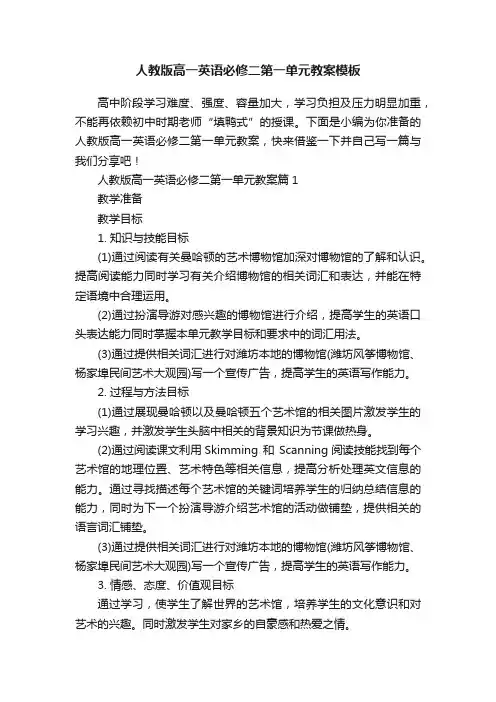
人教版高一英语必修二第一单元教案模板高中阶段学习难度、强度、容量加大,学习负担及压力明显加重,不能再依赖初中时期老师“填鸭式”的授课。
下面是小编为你准备的人教版高一英语必修二第一单元教案,快来借鉴一下并自己写一篇与我们分享吧!人教版高一英语必修二第一单元教案篇1教学准备教学目标1. 知识与技能目标(1)通过阅读有关曼哈顿的艺术博物馆加深对博物馆的了解和认识。
提高阅读能力同时学习有关介绍博物馆的相关词汇和表达,并能在特定语境中合理运用。
(2)通过扮演导游对感兴趣的博物馆进行介绍,提高学生的英语口头表达能力同时掌握本单元教学目标和要求中的词汇用法。
(3)通过提供相关词汇进行对潍坊本地的博物馆(潍坊风筝博物馆、杨家埠民间艺术大观园)写一个宣传广告,提高学生的英语写作能力。
2. 过程与方法目标(1)通过展现曼哈顿以及曼哈顿五个艺术馆的相关图片激发学生的学习兴趣,并激发学生头脑中相关的背景知识为节课做热身。
(2)通过阅读课文利用Skimming 和 Scanning阅读技能找到每个艺术馆的地理位置、艺术特色等相关信息,提高分析处理英文信息的能力。
通过寻找描述每个艺术馆的关键词培养学生的归纳总结信息的能力,同时为下一个扮演导游介绍艺术馆的活动做铺垫,提供相关的语言词汇铺垫。
(3)通过提供相关词汇进行对潍坊本地的博物馆(潍坊风筝博物馆、杨家埠民间艺术大观园)写一个宣传广告,提高学生的英语写作能力。
3. 情感、态度、价值观目标通过学习,使学生了解世界的艺术馆,培养学生的文化意识和对艺术的兴趣。
同时激发学生对家乡的自豪感和热爱之情。
教学重难点教学重点:阅读课文、运用文中相关词汇进行说和写的活动以提高学生读、写、说的能力。
教学难点:在说和写的过程中如何运用相关词汇和表达方式来正确、准确、有效的介绍各个艺术馆的特点。
教学过程(一)展示学习目标与小组评价规则(二)“导入”展示曼哈顿的相关图片,展示课文中出现的5个艺术馆的图片及名字。
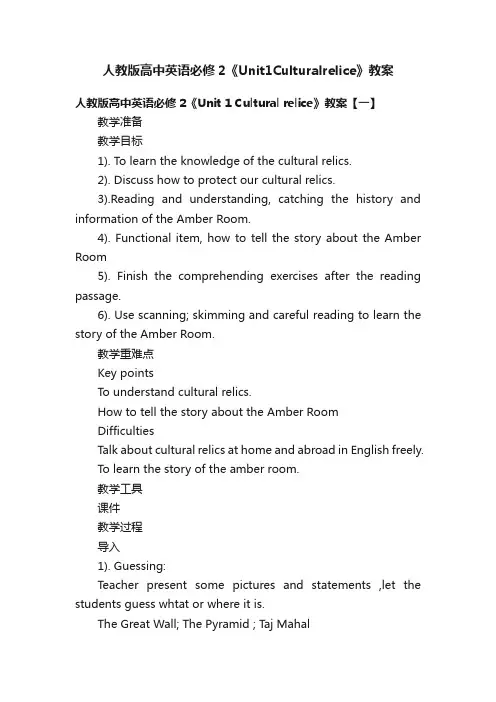
人教版高中英语必修2《Unit1Culturalrelice》教案人教版高中英语必修2《Unit 1 Cultural relice》教案【一】教学准备教学目标1). To learn the knowledge of the cultural relics.2). Discuss how to protect our cultural relics.3).Reading and understanding, catching the history and information of the Amber Room.4). Functional item, how to tell the story about the Amber Room5). Finish the comprehending exercises after the reading passage.6). Use scanning; skimming and careful reading to learn the story of the Amber Room.教学重难点Key pointsTo understand cultural relics.How to tell the story about the Amber RoomDifficultiesTalk about cultural relics at home and abroad in English freely.To learn the story of the amber room.教学工具课件教学过程导入1). Guessing:Teacher present some pictures and statements ,let the students guess whtat or where it is.The Great Wall; The Pyramid ; Taj Mahal2)Teacher show some pictures. They are all very famous places in China or in the world. Ask the students to think these over:A. Can you name them out?Who have the right to own and confirm them?(The shown pictures: Group 1;①Yuanmingyuan; ②Forbidden CityGroup 2: ③Ming Dynasty vase ;④Taj Mahal; ⑤ivory dragon boatand Mogao Caves)Step I: Pre-reading1).Ok, you have know something about cultural relics, have you ever seen a piece of amber?And what do you know about it?Show some pictures of amber. Let students know what the amber is and its value.color yellow- brownfeel like feel as hard as stoneAmber is the fossil(化石) form of resin(树脂) from trees.It takes millions of years to form.2). Can you imagine a house made of amber?Please preview “In search of the amber room.”Step II: Fsat reading and thinking about the title:1). Teacher give students the following questions to think:When you see this title, what do you want to know?What is the Amber Room?Why was it called the Amber Room?What was it made for?What happened to it?Why to search for it?(Ask the students just remember these questions in theirmind not find the answers.)2). Fast reading to get the main idea:The Amber Room , which _________________sent to the Russian people as a _____, was ____by the _____________ soldiers .(Students read the passage quickly and fill in the blans)3). Now, let the students try to answer the questions in part 1). (PPT 7)(Teacher may give some necessary help)Step III: ScanningAsk the students to scan all the names of the person appeared in the text and find out what did they do to the amber room. Join the correct parts of the sentences together. (exercise 1 on page 2)After do the above exercise ,teacher give students a picture of the people in the text and let the students try to tell theclue of the story according to the persons. (PPT 9)Step IV: SkimmingAsk students to skim the passage and complete exercise 2 on page2.( 3 ) How did the Amber Room become one of the wonders of the world?( 5 ) How was a new Amber Room built?( 4 ) How did the Amber Room get lost?( 1 ) How was the Amber Room made?( 2 ) Why did the King of Prussia give the Amber Room to the Czar of Russia as a gift?Step V: Careful readingLet the students read the text carefully and try to find some details to complete the form on PPT 11.Step VI: Role playJust now you have learnt the story of The Amber Room, now suppose you are a guide of The Amber Room, how will you intrduce the amber room to the visitors?( Give students about 3 minutes to have a discussion in group of four ,then ask some of groups to make a role play before all the class.)Homework1. Read the story of The Amber Room again after class.2. Write the introduction of the Amber Room you have discussed in class.3. Prepare for next period by underline the difficult points in the text.板书Blackboard DesignUnit 1 Cultural relicsWarming up & pre-readingWhat is cultural relics?A.a cultural relic is sth. that survived for a long timeB.a cultural relic may be a part of old thing has remained when the rest of it had been destroyedC. a cultural relic is something rather rare人教版高中英语必修2《Unit 1 Cultural relice》教案【二】教学准备教学目标Knowledge and ability: To help the Ss know about the history of the Amber room and develop their reading skills.Process and method: Ss acquire knowledge and improve ability through discussion and competition.Emotion, attitude and values: to arouse Ss's awareness of protecting the cultural relics. Understand cultural relics belong tothe whole world and the human beings.教学重难点important point: Understand the content of the whole passage and master the different reading skills,such as ,skimming, scanning and so on.difficult point : how to solve the questions and find the useful information using the reading skills.教学工具课件教学过程Lead in1. show some pictures .2. show the pictures and a short video of amber room.purpose: motive Ss's interest.Hi, everyone. Let’s look at the screen. I’ll present you some pictures. They are all about cultural relics. Some of them are cultural sites. Some of them are natural sites. Only an international professional organization from UN has the right to decide on and name them.PresentationLook at the photos here. What do you know about the substance of “amber”? What do knowabout the cultural relics “the Amber Room”?discussion:Now, boys and girls, I met a “moral dilemma”. That means I must make a choice between the interests of the family and the interests of the society. Things are like this: My old granny happened to find an ancient vase under a tree in the earth of our garden. It’s so beau tiful and special. Now, my family fell into a moral dilemma. Can you help us to make a decision?A: What should we do?B: Can we keep it for ourselves or report it to the government?C: Have you come across such a situation —to make a difficult choice?listen and answer the questions:Play tape. Ss get the main idea of the passage.Readingpre-reading:1. Have you ever seen a piece of amber?What do you know about it?2. look at the title and the picture. predict what it is about. Then skim it quickly and see if you were right.Reading:1st time:read by yourself as quickly as you can.join the correct parts of the sentences together.2nd time:choices and T/Fcompete between boys and girls.3rd time:answer some question. Ask ss to think over and discuss.purpose: understand the text better and arouse Ss's awareness of competition. Grasp the main information.Discussion and reportThink over of what we discuss in the part of warming up: I find myself falling into the dilemma.you discuss together ,and write down the outline of a report.work in groupConsolidationfill in the blanks (summary).Homeworkmake a report .use the useful information in the passage.。
人教版高中英语必修二《Unit 1 Cultural Heritage》优质课公开课课件、教案Unit 1Cultural HeritagePeriod 3 Discovering Useful StructureRestrictive relative clauses【教材分析】This teaching period mainly deals with grammar “restrictive relative clauses.”To begin with, teachers should lead students to revise what they have learned about the relative pronouns and relative adverbs. A nd then, teachers move on to stress more special cases concerning this grammar, such as the “preposition+relative pronouns which and whom”and cases where we can omit the relative pronouns. T his period carries considerable significance to the cultivation of students’ writing competence and lays a solid foundation for the basic appreciation of language beauty. The teacher is expected to enable students to master this period thoroughly and consolidate the knowledge by doing some exercises.【教学目标】1.Guide students to review the basic usages of relative pronouns and adverbs of attributive clauses.2. Lead students to learn to use some special cases concerning restrictive relative clauses flexibly.2. Enable students to use the basic phrases structures flexibly.3. Strengthen students’ great interest in grammar learning.【教学重难点】1. Help students to appreciate the function of relative pronouns and adverbs of attributive clauses in a sentence2. Instruct students to write essays using theproper relative pronouns and adverbs of attributive clauses.【教学过程】本节语法思考:定语从句在复合句中的作用是什么?关系词有哪些?定语从句在复合句中的作用相当于形容词,它在句中作定语修饰名词或代词。
英语必修二unit1教案(实用版)编制人:__________________审核人:__________________审批人:__________________编制单位:__________________编制时间:____年____月____日序言下载提示:该文档是本店铺精心编制而成的,希望大家下载后,能够帮助大家解决实际问题。
文档下载后可定制修改,请根据实际需要进行调整和使用,谢谢!并且,本店铺为大家提供各种类型的实用资料,如工作总结、工作报告、文案策划、工作计划、讲话致辞、合同模板、教案大全、作文大全、心得体会、其他资料等等,想了解不同资料格式和写法,敬请关注!Download tips: This document is carefully compiled by this editor.I hope that after you download it, it can help you solve practical problems. The document can be customized and modified after downloading, please adjust and use it according to actual needs, thank you!And, this store provides various types of practical materials for everyone, such as work summaries, work reports, copywriting plans, work plans, speeches, contract templates, lesson plans, essays, experiences, and other materials. If you want to learn about different data formats and writing methods, please pay attention!英语必修二unit1教案教案:Unit 1 Friendship教学目标:1.学习并掌握本单元的重点词汇和短语。
2019新人教高中英语选择性必修二Unit 1 Discover Useful Structures 公开课教案Teaching aims:By the end of the period, students will be able to:1.To analyse the forms and features of predicative clauses.2.To learn about the functions of predicative clauses in the context.3.To use predicative clauses in the given context.Teaching key and difficult points:1.Help students to analyse and use predicative clauses.2.Instruct students to use predicative clauses to express their own ideas.Teaching procedures:StepⅠLead-inIn those days,there were two contradictory theories to explain how cholera spread.One theory was that bad air caused the disease.Another was that cholera was caused by an infection from germs in food or water.Snow subscribed to the second theory.One evidence is that a woman and her daughter had died of cholera after moving away from Broad Street.It seemed that she liked the water from the pump so much that she had it delivered to her house every day.The truth was that the water from the Broad Street pump had been infected by waste.1.Can you find any predicative clauses?2.Why do you think they are predicative clauses?3.What are the main linking verbs?Suggested answers:1.In those days,there were two contradictory theories to explain how cholera spread.One theory was that bad air caused the disease.Another was that cholera was caused by an infection from germs in food or water. Snow subscribed to the second theory.One evidence is that a woman and her daughter had died of cholera after moving away from Broad Street.It seemed that she liked the water from the pump so much that she had it delivered to her house every day.The truth was that the waterfrom the Broad Street pump had been infected by waste.2.Because there are linking verbs closely before the predicative sentences.3.Linking verbs{状态类:be,seem,appear,keep,remain, stay...感官类:look,smell,taste,sound,feel...变化类:become,get,turn,grow,fall, come,go...StepⅠObserve and analyseActivity 1Ask and answer the questions in pairs using the information from the reading passage.(P5 Activity 2)(红色部分为学生作答)1.What was Snow’s discovery in two particular streets in London?Snow’s discovery in two particular streets in London was that the cholera outbreak was so severe that more than 500 people died in ten days.2.What was Snow determined to find out during the 1854 outbreak of cholera in London?What Snow was determined to find out was why so many people died/the outbreak of cholera had caused over 500 deaths within ten days.3.What were the exact places Snow marked on the map?The exact places Snow marked on the map were where all those who died had lived/ all the dead people had lived.4.What was the finding that Snow announced?Snow’s finding was that the pump water carried cholera germs/ the water pump was to blame for the spread of cholera.Activity 2Fill in the blanks.1.Snow’s discovery in two particular streets in London was that the cholera outbreak was so severe that more than 500 people died in ten days.2.What Snow was determined to find out was why so many people died.3.The exact places Snow marked on the map were where all those who died had lived.4.Snow’s finding was that the pump water carried cholera germs.Activity 3Fill in the form.引导词that which whether w hat who As if/asthoughwhy when where how作的成分不作成分定语表语不作成分主语宾语表语定语主语宾语表语不作成分状语状语状语状语意思无意思哪一个是否什么谁好像为什么什么时候在哪里如何;怎样Step Ⅰ PracticeActivity 1Complete David’s lines(A~E) by filling in guiding words.(P5 Activity 3) as if that what who when how why whosewhich whetherA.Absolutely.You may not believe it,but that was happened at the initial stage of our group’s research on developing a vaccine for malaria.B.Yes,it is.And it seemed all the theories were useful,but the fact was we couldn’t persuade one another that one theory was better than another.C.Exactly.The problem was not about all our theories were equally good,but in deciding theory to depend upon.D.We realized that what we cared about was not aspect we needed to develop a theory in,but rather we can reduce the cost of a vaccine without reducing its effect!E.You’re right.At last,we became focused on the key issue,which was we had to carry out the research in the first place.Suggested answers:A:what B:as if;that C:whether;whose/which/what D:which/what;how E:whyActivity 2Put A~E in the correct order using the above methods.Then check the answers and state the reasons.(P5 Activity 3)A.Absolutely.You may not believe it,but that was what happened at the initial stage of our group’s research on developing a vaccine for malaria.B.Yes,it is.And it seemed as if all the theories were useful,but the fact was that we couldn’t persuade one another that one theory was better than another.C.Exactly.The problem was not about whether all our theories were equally good,but in deciding whose theory to depend upon.D.We realized that what we cared about was not which aspect we needed to develop a theory in,but rather how we can reduce the cost of a vaccine without reducing its effect!E.You’re right.At last,we became focused on the key issue,which was why we had to carry out the research in the first place.Maria:This mix of theory and data is one of the key characteristics of what we call science.David:______________________________Reason:______________________________Maria:With your theoretical framework?David:________________________________Reason:__________________________________Maria:Deciding on a theory is definitely of critical importance.David:_____________________________________Reason:____________________________________Maria:This was when you should have calmed down and got down to doing some solid work.David:__________________________________________Reason:_________________________________________Maria:So what happened in the end?David:__________________________________________Reason:________________________________________Suggested answers:A(Logical connector)C(Lexical connector) B(Grammatical connector) E(Logical connector) D(Grammatical connector)Activity 3Answer the following questions about the dialogue using the predicative clauses.1.What was David’s group’s research?2.What was the problem?3.What was the key issue?4.What did they care about?Suggested answers:1.David’s group’s research was that they wanted to develop a vaccine for malaria.2.The problem was that they had to decide which theory to depend upon.3.The key issue was why they had to carry out the research in the first place.4.What they cared about was how they could reduce the cost of a vaccine without reducing its effect.StepⅠ Language use and shareActivity 1Work in plete the conversations using the predicative clauses.Every group can choose one or two dialogues,and each member must complete at least two predicative clauses.1.A:Paper making,printing,gunpowder,and the compass are the four great inventions of ancient China.They are significant contributions of the Chinese nation to the world.B:Sure,they are.What I want to know though is .2.A:The ancient Chinese were the first to invent paper and printing.Then they went on to invent books and had opened bookshops in many cities.B:What I’m curious about is .3.A:The compass is a special invention of ancient China,dating back to as early as the Warring States Period.B:Yes.It seems .4.A:Gunpowder was originally used for making fireworks.B:But what surprises me is .5.A:High-speed trains,mobile payments,the bike-sharing system,and online shopping are considered by some as the new “four inventions” of China.B:Is that so? I feel/It seems .Suggested answers:1.which one is the greatest invention/how these inventions have changed China and the world2.who invented paper/how people made the first paper/when ink was invented/what paper was made from/when and how printing spread to the rest of the world/how records were kept before the invention of paper3.that the compass was particularly useful/as if people had to depend on the positions of the sun,the moon,and so on when they were at sea before the compass was invented/that ancient Chinese had developed a good knowledge of magnetism4.that gunpowder was not used initially for firearms/how it is so unexpectedly used today/how heavily mining depends upon it/that it has been generally used not only in industries but in wars across the world5.that these inventions have really made our lives easier/that every Chinese is proud of the new “four inventions”/as if I could not live without them,especially when it comes to online shopping/that we all benefit from all these things/that we may have to remember that every coin has two sidesStepⅠconsolidationⅠ.Fill in the blanks with guiding words.1.Look at the tallest building.That is my father works.2.One of the most exciting moments in my life was I won first place in the singing competition.3.Now,the only problem is we can collect enough money for the project.4.One advantage of solar energy is it will never run out.5.What is troubling me is I don’t have much experience of this kindof work.6.That’s you are wrong.You forgot Step Three.Ⅰ.Choose the best answer.1.Without his support,we couldn’t be we are now.A.howB.whenC.whereD.why2.This is my father has taught me—to always face difficulties and hope for the best.A.howB.whichC.thatD.what3.By boat is the only way to get here,which is we arrived.A.whereB.whenC.whyD.howSuggested answers:Ⅰ 1.where 2.when 3.whether/how/when 4.that 5.that 6.where/whyⅠ 1.C 2.D 3.D。
必修二Unit1 Cultural RelicsReading: In Search of the Amber RoomTeaching aims and denands 教学目标●Learning important points✧To talk about the history of the amber room✧To improve the students’reading abilityHelp students learn the structure and the content of the reading passage.Learning difficult points✧Enable the students to express their ideas logically.✧Enable the students to learn how to give their opinions.●Learning methods✧ Task-based teaching and learning✧ Cooperative learning✧ Discussion●Learning aids✧The multi-media and other normal teaching tools●Learning aims✧Knowledge aims:Get the students to learn the useful new words and expressions in this passage To learn about some details in the history of the amber room.✧Ability aims:Get the students to know the history of amber roomEnable students to give opinions on rebuilding lost cultural relics.Emotional aims:Get the students to learn the cultural relics●Learning proceduresTeaching procedures and ways教学过程Step 1Step 2 lead-inT: Do you know what are cultural relics? (have the students appreciate )four pictures.Ss: They are all cultural relics.T: Look at these picture and discuss with your deskmate. describe the features of cultural relics using this sentence: Cultural relics are something that…T:Now look at these pictures, what are they ?Ss:They are things made of amberT: as we all know, amber is very rare and precious. Can you imagine here’s an entire room made of amber? Let’s appreciate some pictures.Today We will get to know more about the wonderful Amber Room in this class.Step 3 ReadingTask 1 ScanningRead the text quickly and find out the main idea of the passage: (5min.)✍ It tells us the strange history of the amber room, a cultural relic of two countries: Russia and Germany. ✍ main idea of each paragraph (4min.)Para1. The amber room and its designPara2-3. The history of the amber roomPara4. The missing of the amber roomPara5. The rebuilding of the amber roomTask 2 SkimmingRead the passage quickly and find out characters, years and places in the passage. (clues 线索)(3min.) characters: Frederick I, Peter the Great, Frederick William I, Catherine II.Background information:Frederick I: the first king of Prussia.Frederick William I: the next king of Prussia.Peter the Great : the Czar of Russia.Catherine II: the female Czar of Russia.years: 1716, 1770, 1941, 2003.places: Prussia, Russia, Germany.Task 3 Careful readingRead the passage carefully and answer the following two questions:1) What did these four characters do to the amber room?2) What happened in these four years( 1716; 1770; 1941; 2003)Para1. (3min.)✍ What was the amber room made of?Several tons of amber was were used to make it. It was also decorated with gold and jewels.✍ How many years did the artists take to make the amber room?It took about ten years.Para2. (5min.)✍ For what reason was the amber room first designed?It was first designed for the palace of Frederick I.✍ What did Peter the Great give in return?A troop of his best soldiers.✍ What was the amber room used for when it belonged to Peter the Great?It served as a small reception hall for important visitors. Q2: What happened to the Amber Room in 1716?Frederick William I (the king of Prussia) 1. his in St Petersburg2. a small for important visitors.as a gift of friendship gave to in return to served as(the Czar)Sent him his best soldiersPeter the Great a troop of winter palace reception hallPara3. (2min.)✍ What did Catherine II use the amber room for?She spent her summers in the amber room.✍ What could you see in the amber room after it was completed?Almost six hundred candles lit the room, and its mirrors and pictures shone like gold. Para. 4:the missing of the Amber RoomTime :Event:1941.9Russia(the Russians)Nazi Germany (the Nazis)at war stole .the Nazis arrived sent it to Konigsberg.After that ,whathappened to theAmber Roomwas .were only able toremove .furniture and small art objects the Amber Room a mystery (5min✍ True or False( T ) Germany and Russia were at war in 1941.( F ) All things in the Amber Room were stolen.( T ) The Nazis stole the Amber Room within two days. Para5. (3min.)✍ Who have built a new amber room?The Russians and Germans.✍ How old is St. Petersburg now?312 years old now.Post-readingSumming up1. Characteristics: in the order of time; the past tense. (2min.)2. The clues of the story. (3min.)一、Homework (1min.)1. Retell the story and write it in your exercise book.Clue: built→gave to sb. As a gift→added more details→stolen→lost→rebuilt2. Find out the 7 attributive clauses in the reading passage, write it down in your exercise book, 并标出定语从句部分以及先行词、关系代词/关系副词。
M2 Unit1 Cultural HeritageReading and ThinkingMotto: Heritage is our legacy from the past, what we live with today and what we pass on to future generations.——World Heritage Center【学习目标】1.To learn different reading skills and understand how a problem was solved.2.To understand the importance of the protection of the cultural heritage.【重点、难点】Understand the importance and necessity of the protection of the cultural heritage.【导学流程】一、基础感知Pre-reading:Read the title and look at the photos or video. What do you think the text is about?________________________________________________________________________________While-readingTask 1Read the text again and answer the questions.(1). How were the temples and other cultural sites saved?________________________________________________________________________________(2). How long did it take to complete the project?________________________________________________________________________________Task 21. Why did the Egyptian government attempt to build the Aswan Dam? ( )A.To produce electricityB.To control floodsC.To supply water to more farmers in the areaD.All of the above2. Why did the building of the Dam lead to protests? ( )A.It will damage the fieldsB.It will cost a lot of moneyC.It will damage the cultural relicsD.It will damage the natural environment3. How did the government save the cultural relics? ( )A.By stopping the projectB.By moving them to a safe placeC.By repairing cultural relicsD.By calling for donation4. What can be learned from the Aswan Dam project? ( )A.It is not suitable for the present timeB.The protection of cultural sites is easyC.The cooperation can solve difficult problemsD.The cultural heritage sites are disappearing because of constructionPost-reading:Finish the timeline with the information from the text and tell me how the text is developed.1950, 1960, 1961, over the next 20 years, 1980________________________________________________________________________________Discussion and summary.________________________________________________________________________________ ________________________________________________________________________________探究疑惑:________________________________________________________________________________ ________________________________________________________________________________ ________________________________________________________________________________ ________________________________________________________________________________ ________________________________________________________________________________ ________________________________________________________________________________ ________________________________________________________________________________ ________________________________________________________________________________。
必修二Unit1 Cultural Relics
Reading: In Search of the Amber Room
一、Pre-reading (4min.)
What do you think amber can be made into? (necklace, ring, barrette, bracelet, perfume bottle, etc.)
Can you imagine a room made of amber?
二、Learning aims
1. Help students learn the structure and the content of the reading passage.
2. To learn about some details in the history of the amber room.
三、Reading
1.Fast reading
1) Read the text quickly and find out the main idea of the passage: (5min.)
① It tells us the strange history of the amber room, a cultural relic of two countries: Russia and Germany.
② main idea of each paragraph (4min.)
Para1. The amber room and its design
Para2-3. The history of the amber room
Para4. The missing of the amber room
Para5. The rebuilding of the amber room
2)Read the passage quickly and find out characters, years and places in the passage. (clues 线索)(3min.)
① characters: Frederick I, Peter the Great, Frederick William I, Catherine II.
Background information:
Frederick I: the first king of Prussia.
Frederick William I: the next king of Prussia.
Peter the Great : the Czar of Russia.
Catherine II: the female Czar of Russia.
② years: 1716, 1770, 1941, 2003.
③ places: Prussia, Russia, Germany.
2.Careful reading
Read the passage carefully and answer the following two questions:
1)What did these four characters do to the amber room?
2)What happened in these four years( 1716; 1770; 1941; 2003)
Para1. (3min.)
① What was the amber room made of?
Several tons of amber was were used to make it. It was also decorated with gold and jewels.
② How many years did the artists take to make the amber room?
It took about ten years.
Para2. (5min.)
① For what reason was the amber room first designed?
It was first designed for the palace of Frederick I.
② What did Peter the Great give in return?
A troop of his best soldiers.
③ What was the amber room used for when it belonged to Peter the Great? It served as a small reception hall for important visitors. as a gift of friendship gave to in return served (the Czar)
his best soldiers
Peter the Great Para3. (2min.)
① What did Catherine II use the amber room for?
She spent her summers in the amber room.
② What could you see in the amber room after it was completed?
Almost six hundred candles lit the room, and its mirrors and pictures shone like gold. the Nazis arrived .
furniture and small art objects
③ True or False
( T ) Germany and Russia were at war in 1941.
( F ) All things in the Amber Room were stolen.
( T ) The Nazis stole the Amber Room within two days.
Para5. (3min.)
① Who have built a new amber room?
The Russians and Germans.
② How old is St. Petersburg now?
312 years old now.
四、Post -reading
Summing up
1. Characteristics: in the order of time; the past tense. (2min.)
2. The clues of the story. (3min.)
五、Homework (1min.)
1. Retell the story and write it in your exercise book.
Clue: built→gave to sb. As a gift→added more details→stolen→lost→rebuilt
2. Find out the 7 attributive clauses in the reading passage, write it down in your exercise book, 并标出定语从句部分以及先行词、关系代词/关系副词。